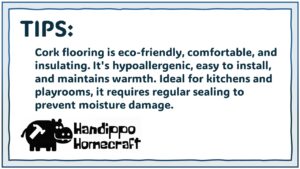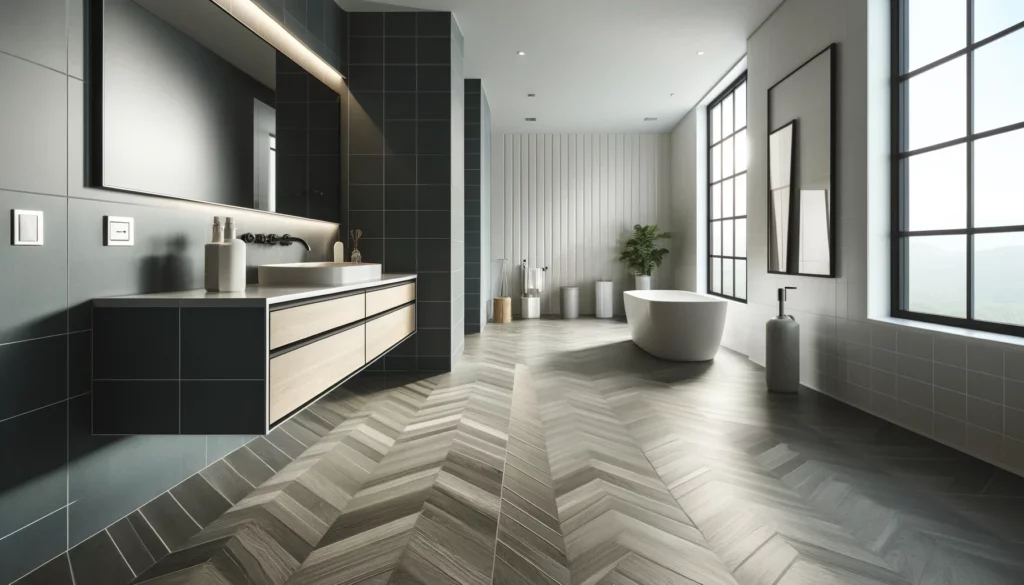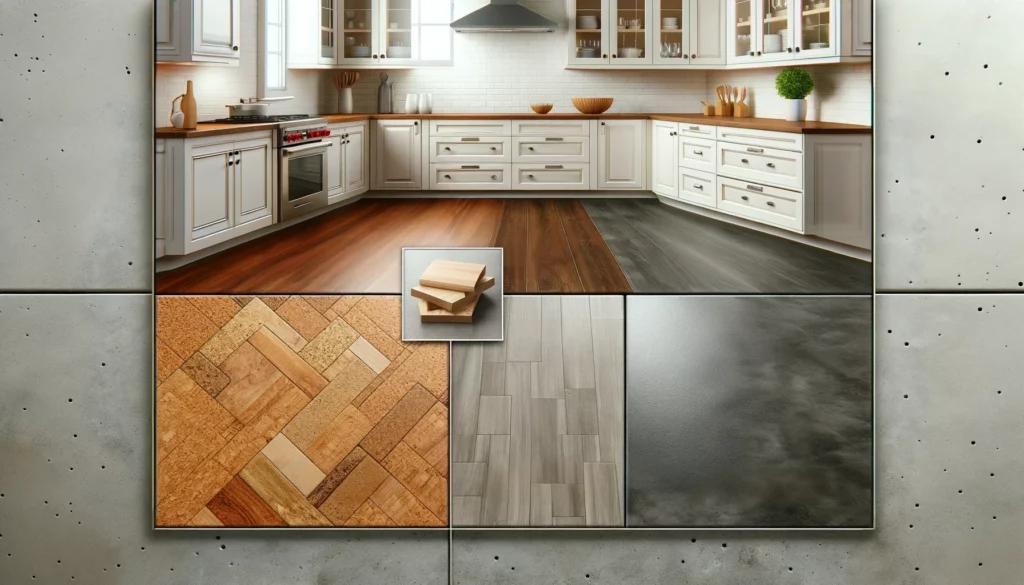Advantages and Disadvantages of Cork Flooring: The Natural and Sustainable Option
As people search for sustainable options in flooring, the market has reacted to meet a new demand with stylish and long-lasting flooring. One of the most popular is hardwood floors, but here is a relative newcomer in the game – cork flooring.
Cork is a unique combination of natural beauty, versatility, and sustainability that can be a serious contender against traditional flooring options. A part of navigating the world of home improvement includes understanding the pros and cons of cork flooring. In this guide, we will take an in-depth look at this revolutionary flooring solution, from what it is and how it is made to installation, care, and the differences between this and other popular choices.
For detailed information about home flooring, don’t miss our Flooring Face-Off: What is the Most Popular Flooring in 2024

What is Cork Flooring?
Cork comes from the bark of the cork oak tree (Quercus suber), which is native to the Mediterranean. There upfront costs were around $31k, so hopefully those cork trees will start pouring rip into her pockets! The good news is that cork trees are a renewable resource & their barks can be harvested every nine years without damaging the tree. Since it is part of the life cycle of the cork oak tree the bark can be stripped back every 9 to 12 years thus allowing the tree to stay alive and keep propducing cork, meaning an excellent example of a truly CO2 negative process.
The harvested bark is then processed into tile and plank flooring. These sheets are first boiled to extract the bark, which is then ground into granules. These granules are mixed with a binder, pressed into blocks, and baked at various temperatures to make various colored and textured tiles or planks. The result is a sturdy, adaptable and attractive flooring material.

Advantages of sustainable flooring
Its ultra-sustainable and one of the most compelling reasons to think about cork flooring. Cork is one of the few flooring materials that comes from a renewable resource rather than oil or oil derivatives. This sustainable mindfulness is attractive to homeowners who would like the idea of doing more green initiatives in their home. Secondly the harvesting is done in a manner that prevents damage to the cork oak trees allowing the commodity to be managed as a sustainable resource for the generations ahead.
In this guide we will dive into the details behind the pros and cons of installing cork flooring, so that you can decide if cork flooring is really the best option for your home. All you need to know about the benefits that it provides, the disadvantages, as well as the way to effectively install and maintain this clean, natural flooring material that is cork.
Cork Flooring – A Closer Look at the Benefits
There is no doubt that cork flooring offers a number of benefits that are difficult to ignore for many people when we look at the list of advantages they have to offer as a natural, soft and sustainable flooring option. World Tour from the eco-friendly origins to unique performance specifications, cork provides a different package of benefits that singles it out from other treatments.
Comfort and Warmth Underfoot
Cork flooring is renowned and appreciated for its natural ‘springiness’. Cork has a natural texture that is soft, flexible, and spongy due to the unique cellular structure of cork, which is filled with air. That same cushion translates to a warm and inviting feel underfoot, which is why cork flooring is often used in spaces where walking with bare feet is done, such as bedrooms, living rooms, and playrooms.
In addition because of cork’s natural cushioning it also contributes to less foot strain making it less fatigue on your feet which is perfect for those that work long hours on their feet either standing at a workbench for long periods or strolling around the house when wearing shoes is the last on their minds. This can be particularly useful in kitchens, where it is necessary to have a comfortable stance for hours of cooking or the preparation of dishes.
Quiet Home: Sound Reduction
Cork flooring is also noise resistant. Its cellular composition is absorbing sound, so if the requirement in your area is even too hush hush then cork is a great choice. This is especially useful in homes with children and even pets because cork flooring seeks to reduce the noise of foot traffic, playing and falling it acquires. Cork flooring is also a great option for apartments or multi-level homes as it helps to reduce noise transmission throughout floors.
A Healthier Choice: Hypoallergenic and Antimicrobial
The Advantages of Cork Flooring(predictions) It is naturally hypoallergenic so it will not harbor allergens such as dust mites, mold, or pollen. Plus, its ability to freshen up the air can also benefit people with allergies or anyone who might be sensitive to allergens, making it an ideal solution to help improve your indoor air quality and create a healthier living space in general. Cork is also naturally antimicrobial so it discourages the growth of bacterial and mold. This can be particularly good in areas like bathrooms where moisture is left behind, which can encourage the growth of mold, mildew and other problems.
All in all, those factors help to make cork flooring sound very attractive to householders looking for an earth-friendly, comfortable, and convenience-built choice.
The Downsides of Cork Flooring: Confronting Potential Flaws
Although cork flooring has many positive attributes, there are also some potential downsides to think about. Like allflooring materials, cork has its good features and bad features that you need to consider when you are thinking where can i buy floor in san antonio tx for your home.
Scratches and Dentsermalink
What is most frequently complained about is how soft cork flooring can be. Cork is pretty durable but its texture makes it a bit more prone to scratches and dents than harder flooring materials such as hardwood or tile.
Cork Flooring can be easily damaged by sharp objects, heavy furniture, and pet claws. Although this risk may be lessened with proper care and attention, you’ll want to be aware of this possibility and make sure to take extra steps to promote the health of your floors.
Fading in Sunlight
One other potential drawback of using cork flooring is that it can fade in sunlight. Cork can also fade and become discolored in prolonged direct sunlight (primarily with lighter shades).
If you see a lot of direct sunlight in your home, especially in basket rooms with large windows, you will need to think about using window coverings to block some of the sunlight and protect your cork floor from UV damage.
The Concrete Cure and Sealing Maintenance Requirements
You need to perform routine care of your cork flooring to keep it looking beautiful and lasting as long as possible. Cleaning cork floors is not particularly difficult, but there are a few important points to keep in mind:
- Sweep or Vacuum: To Keep your cork floor clean, it is important that you sweep away dust and debris, on a daily basis to prevent dirt from scratching the surface.
-
Damp Mopping: Deeper cleaning using mild cleaning solution and a slightly damp mop. Dampen a cloth slightly but do not soak it, and never use undiluted chemicals, sterilising agents or excess water as this will damage the cork.
-
Required sealing: Cork must be sealed when installed and resealed regularly to help protect it from scratches, stains, and moisture. How often you reseal will vary on type of sealant used and how much foot traffic the floor receives.
Being aware of these potential cons can allow you to make the most informed decision as to whether or not cork flooring is right for your home.
Cork Flooring Guide: Choosing and Installing Cork Floors
One of the point of installing cork floor tiles is the ability to complete the job as a DIY project. But, you need to be very cautious about the installation process in order to get good results. This chapter will cover everything you need to know about selecting and installing your new cork flooring.
Cork Flooring Forms: How to Choose the Right One
Cork flooring can be found in a range of designs as well as layouts with their very own collections of pros and cons. Above is a simple breakdown of some of the most popular types cork flooring
- Glue-Down Tiles: These tiles are best known for their strength and enduring nature, making it a suitable option for dealing the high volume foot traffic.
-
Floating Planks: they do not require adhesive because the click-and-lock system enables one to install them. They lay on top of the subfloor and “float” to create a flexible and forgiving surface. Floating planks are typically easier for do-it-yourselfers to install than glue-down tiles.
-
Self-tile adhesive: these come with a sticky backing so no extra adhesive or glue is required. This means that they can be installed quickly if you do not have much space, or if you want to keep things simple.
If you have chosen cork flooring for your home, as one of the most sustainable building materials, the next question is often what type of cork flooring is the best for the home.
Subfloor Preparation for a Smooth and Stable Base
One of the most important final touch that must be done before cork flooring is installed is prepping the subfloor. Best Installation and most life use cork floor is over a smooth, level, stable subfloor. Following are the steps involved in subfloor preparation:
- Subfloor Leveling: Using the level, mark any areas that are uneven, and apply a self-leveling compound to correct any high or low spots.
-
Fixing a Damaged Subfloor: Fill the cracks or gaps with a patching compound appropriate for floor repairs.
-
Moisture Barrier: A moisture barrier will prevent damage to the cork from excessive moisture, so use one if you suspect that your subfloor may be damp.
You should level the subfloor, which would make sure your cork floor gets perfectly installed and provide you with years fo worry-free usage.
More On The Care and Maintenance Of Cork Flooring
Cork flooring, like all flooring surfaces, is one of the most important when it comes to maintenance to keep it beautiful and long-lasting. Thankfully, with a little love and elbow grease here is how you can make sure your cork floors look beautiful for years!
Quick Clean: sweep, vacuum, wet mop
Cork Flooring: The Most Important Rule for Keeping Your Floor Clean to Stop Dirt and Dust Cleaning your cork floors is easy with a simple routine.
- Sweep or Vacuum: Sweep or vacuum you cork floors regularly to keep lose dirt off it. Scrub the surface with a soft-bristled brush or use a vacuum cleaner with a soft upholstery attachment to prevent scratching it.
-
Damp Mop Floors: On a slightly regular basis, mop the floors with a water and vinegar solution, or a damp mop with a small amount of soapy water for a more thorough clean. When cleaning cork, the first thing you want to make sure of is you are not using any harsh chemicals or too much water (since they can ruin the material).
Sealing: Applying A Finish To Protect Your Flooring
Sealing is a vital cork floor maintenance step. A good sealant will protect the surface from scratches, stains, and moisture. A couple of things you need to know about sealing:
- Sealing: When you lay a cork flooring you need to seal the corking with a floor sealer. Using a sealant should help create a barrier and make the floor last longer.
-
Re-Sealing: Cork floors will need fresh coats of sealer every few years depending upon the quality of the original seal and the amount of foot traffic on the floor. Follow the re-sealing intervals as recommended by the manufacturer.
Addressing Stains and Spills
Of course, accidents do happen but the faster you act the less likely that your cork floors will stain or be damaged. When Spills Happen Do This:
- Clean Up Spills Immediately: Quickly and carefully wipe up spills to avoid allowing them to seep in and stain the cork. A cloth or sponge with a mild cleaning solution
-
DO NOT USE Harsh Chemicals: Do not use any strong chemical or harsh cleaner on your cork floors as these can damage the finish and leave a scum, water or streak marks.
Cork Flooring: Frequently Asked Questions
Is cork flooring waterproof?
Water-Resistant: Yes, Waterproof: No. Cork flooring While it can handle the occasional spill or splash, continued exposure to liquid will ruin the bag. Good sealing can also help maintain a water resistance, but should NOT be used in a wet area regardless because it is still an organic material and will eventually fail.
Is Cork Flooring Durable?
Cork flooring will last 10-30 years with proper care and maintance. Factors such as foot traffic, sunlight exposure, and the quality of the installation can impact the longevity of the material.
What does a new cork floor cost?
You may even discover that your choice in Cork Flooring can be quite well within your budget, if not even save you money. It is usually more expensive than vinyl flooring, while costing somewhere between vinyl and wood. Cork flooring: Between $4 and $8 per square foot.






